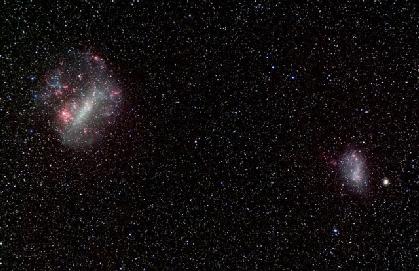
The Large and Small Magellanic clouds, orbiting the Milky Way (copyright RSAA/ANU).

Below is a description of some of the work I have done and some of the projects I have participated in concerning dwarf galaxies. Unfortunately, lack of time prevents me from putting on the web everything I am involved in, but my publications list (which is up-to-date) should alleviate this problem somewhat.
My interest in dwarf galaxies centers around so-called dwarf irregular and blue compact dwarf (BCD) galaxies. I am particularly interested in their dark matter content and distribution, (self-propagating) star formation, and environmental influences, mainly through HI observations.
| ESO 364-G 029 | HoII | NGC 2915 | FCC 35 |
ESO 364-G 029:
Together with
Thijs Kouwenhoven (University of Sheffield), I
have carried out a multi-wavelength study of the dwarf Magellanic
irregular galaxy ESO364-G029, part of an effort to enlarge the number
of well-studied Magellanic-type galaxies. We obtained both broadband
optical imaging and neutral hydrogen radio synthesis observations. The
optical morphology characteristically shows a bar-like main body with
a one-sided spiral arm, an approximately exponential light
distribution, and offset photometric and kinematic centers. The HI
distribution is mildly asymmetric and, although slightly offset from
the photometric center, roughly follows the optical brightness
distribution, extending to over 1.2 Holmberg radii. In particular, the
highest HI column densities closely follow the bar, one-arm spiral,
and a third optical extension. The rotation is solid-body in the inner
parts but flattens outside of the optical extent. The total HI flux
F_HI = 23.1 Jy km/s, yielding a total HI mass M_HI = 6.4x10^8 M_sun
and a total HI mass-to-blue-luminosity ratio M_HI/L_B = 0.96
M_sun/L_Bsun. The HI data suggest a very complex small-scale HI
structure, with evidence of large shells and/or holes, but deeper
observations are required for a detailed study. Follow-up observations
are also desirable for a proper comparison with the Large Magellanic
Cloud, where despite an optical morphology very similar to ESO364-G029
the HI bears little resemblance to the optical.
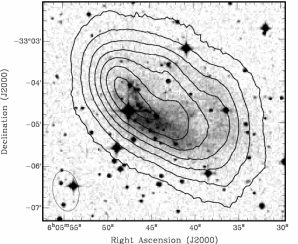
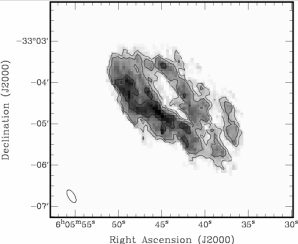
A paper describing this work has appeared in Kouwenhoven, M. B. N., Bureau, M., Kim, S., & de Zeeuw, P. T. 2007, A&A, 470, 123. You can also download it here in preprint format.
HoII:
Over a period covering my undergraduate, graduate, and postdoctoral
years, I worked on meutral hydrogen VLA D-array observations of the
dwarf irregular galaxy Holmberg II in collaboration with Prof. Claude
Carignan (Université de
Montréal). HoII is a prototype galaxy for studies of shell
formation and the data were extracted from the multi-configuration
dataset of
Puche et al. (1992). We detected HI to radii over 16' or 4 R_25,
almost a factor of two better than previous studies. The total HI mass
is 6.44x10^8 Solar masses. The integrated HI map has a comet-like
appearance, with a large but faint component extending to the
northwest and the HI appearing compressed on the opposite side. This
suggests that HoII is affected by ram pressure from an intragroup
medium (IGM). The velocity field shows a clear rotating disk pattern
and a rotation curve corrected for asymmetric drift was
derived. However, the gas at large radii may not be in equilibrium.
Puche et al. (1992) multi-configuration data were also reanalyzed
and we showed that they overestimated their fluxes by over 20%.The
rotation curve derived for HoII is well defined for radii up to 10
kpc, but for 10-18 kpc the velocities are only defined on the
approaching side, such that this part of the rotation curve should be
used with caution. An analysis of the mass distribution, using the
whole extent of the rotation curve, yields a total mass of 6.3x10^9
Solar masses, of which about 80% is dark. Similarly to what is seen in
many dwarfs, there is more luminous mass in HI than in stars. One the
other hand, luminous matter dominates within the optical body of the
galaxy and dark matter only in the outer parts, analogous to what is
seen in massive spirals rather than dwarfs.
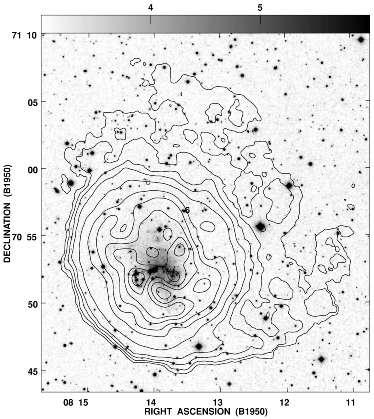
HoII lies northeast of the M81 group's core, along with Kar52 (M81 Dwarf A) and UGC4483. No signs of interaction are observed, however, and we argued that HoII is part of the NGC2403 subgroup, infalling towards M81. This suggests ram pressure stripping and the presence of an IGM in the M81 group. Stripping of the outer parts of the disk would require an IGM density greater than 4.0x10^-6 atoms cm^-3 at the location of HoII. This corresponds to about 1% of the virial mass of the group uniformly distributed over a volume just enclosing HoII and it is consistent with the known X-ray properties of small groups. The HI tail is also consistent with additional turbulent viscous stripping and evaporation, at least for low IGM temperatures. We argued that existing observations of HoII do not support self-propagating star formation scenarios, whereby the HI holes and shells are created by supernova explosions and stellar winds. Many HI holes are located in low surface density regions of the disk, where no star formation is expected or observed. We discussed various alternative mechanisms and suggest that ram pressure can help. Ram pressure has the capacity to enlarge preexisting holes and lower their creation energies, helping to bridge the gap between the observed star formation rate and that required to create the holes.
A paper describing this work has appeared in Bureau, M., Carignan, C. 2002, AJ, 123, 1316. You can also download it here in preprint format.
NGC2915:
During my PhD
thesis at MSSSO, I became
interested in the unique blue compact dwarf (BCD) galaxy NGC2915. I
studied it in detail along with
Prof. Ken Freeman (MSSSO),
Dr. David Pfitzner (then at
MSSSO) and Dr. Gerhardt
Meurer (Johns Hopkins
University). NGC 2915 is a blue compact dwarf galaxy with a very
extended H I disk. This disk shows a short central bar and extended
spiral arms, both reaching far beyond the optical component. We used
Tremaine & Weinberg's method to measure the pattern speed of the
bar and spiral arms from the HI radio synthesis data, the first time
this was achieved in a late-type gas-rich system. Our measurements
yield a pattern speed of 0.21+/-0.06 km s^-1 arcsec^-1 (8.0+/-2.4 km
s^-1 kpc^-1 for D=5.3 kpc), in disagreement with the general view that
corotation in barred disks lies just outside the end of the bar, but
consistent with recent models of barred galaxies with dense dark
matter halos. Our adopted bar semilength, r_b=180 arcsec, puts
corotation at more than 1.7 r_b. The existence of the pattern is also
problematic. Because NGC2915 is isolated, gravitational interactions
can not account for the structure observed in the HI disk. We also
argued that the low surface density observed in the disk and the
location of the pseudorings make it unlikely that swing amplification
or bar-driven spiral arms can explain the bar and spiral
pattern. Based on the similarity of the dark matter and HI surface
density profiles, we discussed the possibility of dark matter
distributed in a disk and following closely the HI distribution. The
disk then becomes gravitationally unstable and can naturally form a
bar and spiral pattern. This explanation is however difficult to
reconcile with other properties of NGC2915. We also considered the
effect of a massive and extended triaxial dark matter halo with a
rotating figure. The existence of such halos is supported by cold dark
matter simulations showing strongly triaxial dark halos with slow
figure rotation. The observed structure of the HI disk can then arise
through forcing by the rotating triaxial figure. We thus associate the
measured pattern speed in NGC2915 with the figure rotation of its dark
halo. If our interpretation is right, objects like NGC2915 offer new
opportunities to probe the structure and dynamics of dark halos.
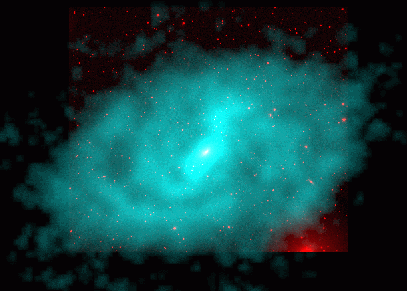
A paper describing this work has appeared in Bureau, M., Freeman, K. C., Pfitzner, D. W., & Meurer, G. R. 1999, AJ, 118, 2158. You can also download it here in preprint format.
Following this work, Frederic Masset ( CE-Saclay, UNAM) and I carried out further numerical modeling to discriminate between the triaxial halo and heavy disk hypotheses. Hydrodynamic simulations were run for each case and compared to observations using customized column density and kinematic constraints. The spiral structure can be accounted for by both an unseen bar or triaxial halo, but the large bar mass or halo pattern frequency required make this unlikely. In particular, the spin parameter is much higher than predicted by typical cold dark matter structure formation scenarios. The massive disk models show that when the observed gas surface density is scaled up by a factor about 10, the disk develops a spiral structure resembling closely the observed one. This is consistent with more limited studies in other galaxies and suggests that the disk of NGC2915 contains much more mass than is visible, tightly linked to the neutral hydrogen. A classic (quasi-)spherical halo is nevertheless still required, as increasing the disk mass further to fit the circular velocity curve would make the disk violently unstable. Scaling the observed surface density profile by an order of magnitude brings the disk and halo masses to comparable values within the disk radius, but the surface density remains under Kennicutt's star formation threshold for a gaseous disk and no stars are expected to form, as required by observations.
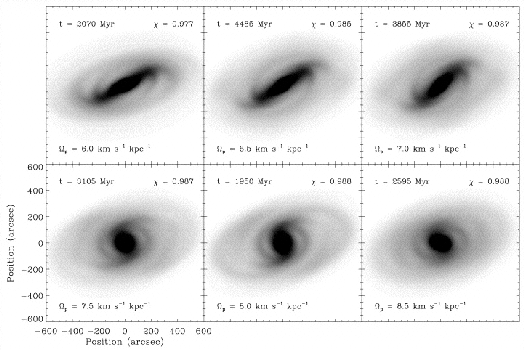
A paper describing this work has appeared in Masset, F., Bureau, M. 2003, ApJ, 586, 152. You can also download it here in preprint format.
FCC35:
During my PhD
thesis at MSSSO, I followed
up on intriguing observations of the galaxy FCC35 obtained during my
study of the Fornax cluster. This
work was in collaboration with Dr. Mary
Putman ( University
of Michigan),
Jeremy Mould ( NOAO), Dr. Lister
Staveley-Smith (ATNF),
and
Prof. Ken Freeman (MSSSO). The Fornax cluster galaxy
FCC35 shows an unusual multiply peaked integrated HI profile. We thus
observed FCC35 with the
ATCA (ATNF) and found
a compact HI source of 2.2x10^8 Solar masses and a spatially
overlapping complex of HI gas with the same mass. By combining optical
observations with HI data, it is clear that FCC35 is a young compact
source of star formation with associated HI and a nearby intergalactic
HI cloud devoid of stars. FCC35 is thus a blue compact dwarf (BCD) or
HII galaxy, having large amounts of neutral hydrogen, very blue colors
(U - V=0.1), and a low-metallicity spectrum with strong narrow
emission lines. Together with the presence of the HI cloud, this
suggests that FCC35 and the high star formation rate within it may be
the result of a recent interaction within the Fornax cluster.
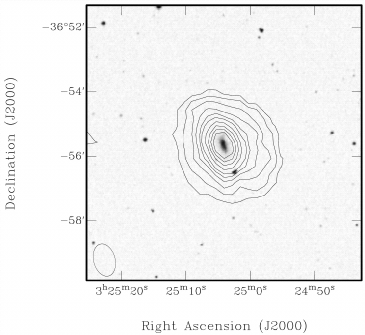
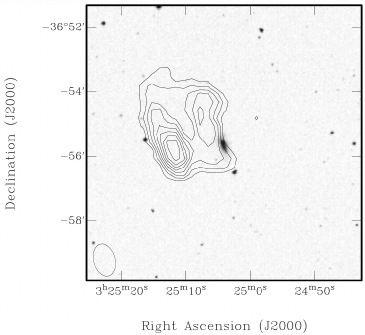
A paper describing this work has appeared in Putman, M. E., Bureau, M., Mould, J. R., Staveley-Smith, L., & Freeman, K. C., AJ, 115, 2345. You can also download it here in preprint format.
To go back to my Home Page, click here:
![]()
This page was last modified on August 1 2007